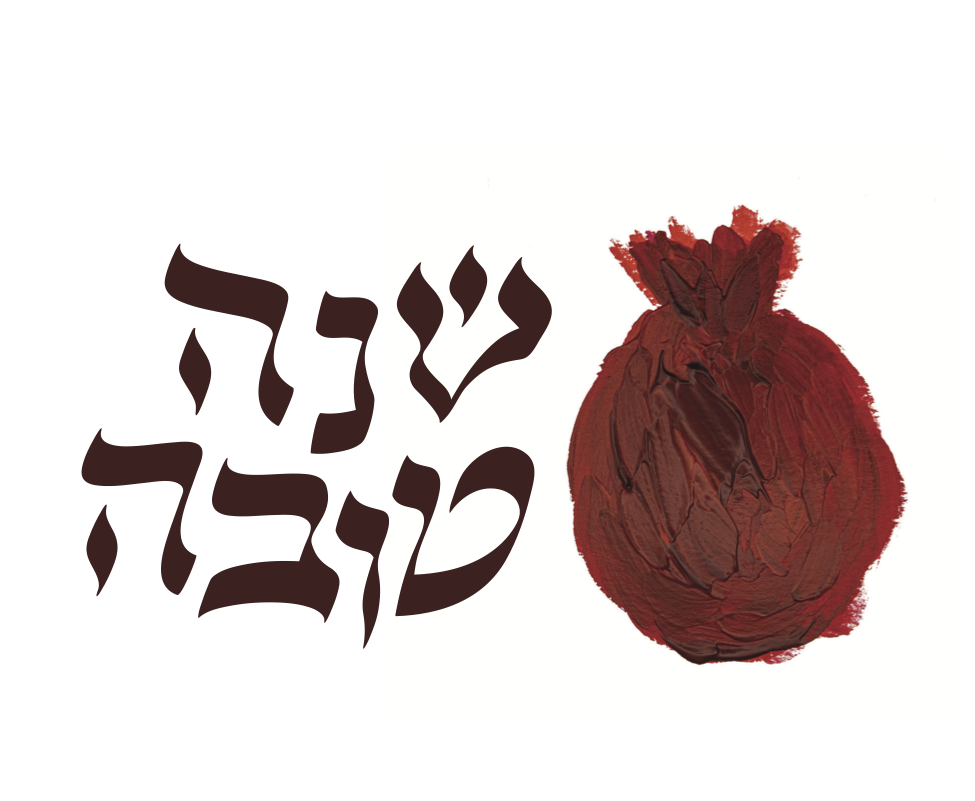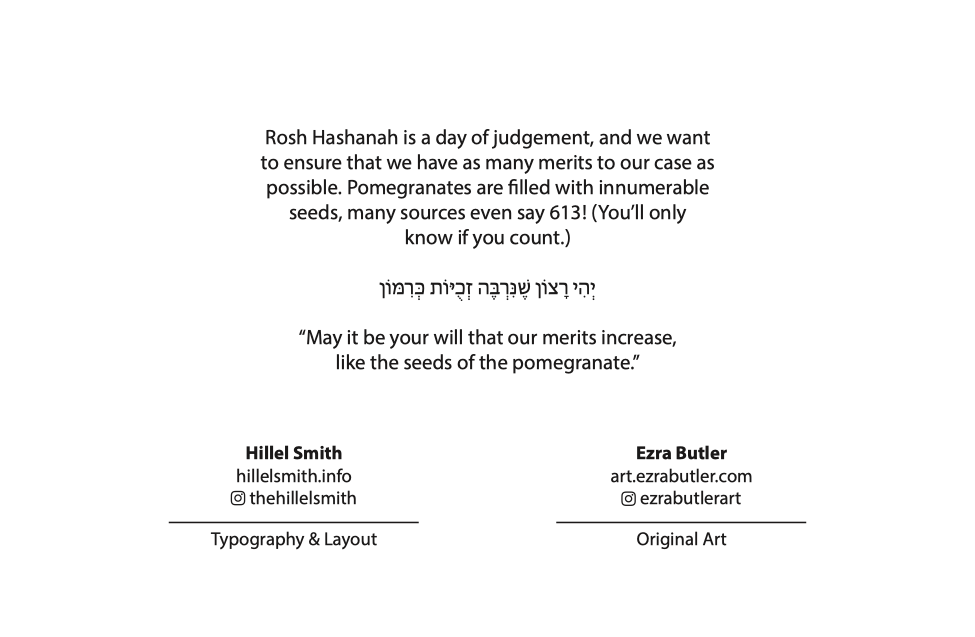On Pomegranates, Color, and Symbolic Creativity
A Colorphilia Rosh Hashanah sermon

This is an early newsletter this week, in order to wish Shana Tova (Happy New Year) to all Colorphilia subscribers, regardless of if you celebrate Rosh Hashanah or not. I'm accepting the fact that this particular newsletter had become quite sermonic, so I just leaned into it.
On Rosh Hashanah, it is customary to eat symbolic foods, like an apple dipped in honey, fish, and pomegranates, as an opportunity to express positive blessings for the new year. Four years ago, I created a collection of Shana Tova cards featuring my art, in collaboration with artist and typographer Hillel Smith.

Adaptive Symbolic Creativity
At that point I wrote about the idea of “adaptive symbolic creativity”, in other words finding meaning in the foods to which one has access.
The Jewish tradition is full with this sort of adaptive symbolic creativity.
Take the ubiquitous carrot, for example. One of the vegetables the Yiddish speaking Jews of Eastern Europe had access to were carrots, so they created a different wordplay for carrots to act as a symbol for “more good deeds”, because the word in Yiddish was “mehren” and “mehr” means more.
Or the humble beet, the central ingredient in a delicious borscht, any time of year, warm or cold. It was a common, accessible vegetable, so they came up with some other wordplay. The word in Hebrew is “selek”, which sounds like the verb “to remove”. Therefore, on Rosh Hashanah, you symbolically eat beets in order to remove your enemies.
The Pomegranate
The complex etymology of pomegranate is, in fact, related to this same aspect of adaptive symbolic creativity. The most basic understanding is from the Latin for malum granatum or seed fruit.
The Fruit
In Hebrew, Arabic, and other languages, the word for the fruit is related to rmn (rimon), which was a very specific shape. As a shape it is cited in Exodus 28:34. Josephus, in his Antiques of the Jews, seems to indicate that “pomegranates” on the vestments of the High Priest, were actually dyed the color of pomegranate.
There is also a crown on the fruit, which seems to indicate a level of royalty as well.
The Seeds
Even in Greek, the fruit was described as one word, and the seeds as another.
These are the seeds that Persephone ate, and therefore had to live in the underworld in Hadestown fora third of the year. This was the myth used to describe the seasons of the year, and would an apropos fruit to eat on the precipice of autumn and winter.
Red Dye
In Greek these seeds were referred to as κόκκον (kokkon), or otherwise, the same word we would use to describe the cochineal (coccinus in Latin). We’ve mentioned this as a the color based on the insect, the Kermes, or the cochineal beetle that would be made into a red dye.
In fact, seeds or grains become so intertwined with the idea of the red cochineal / kermes dye, that people explain that the phrase “dye in grain” or “in grain” to refer to dyeing use the kermes dye.
I think that the case could be made that the original dye of the pomegranate seed / grains was likely the one referred to in middle English and early modern English quotes. Pomegranate was the more likely red dye to be used by people in European countries, as is evident in numerous books from the period.
Granada, Andalusia
There seem to be many sources that quote "the grain of Spain", or "Portugal", or "Granada", but those all seem to be misunderstandings of what the word “granata” was referring to. It was not referring to the place of origin, necessarily, rather to the seeds.
That said, people connect Granada with the color red of the dirt, so it is possible that the city was named after the seeds, rather than vice versa. It connects to the Arabic name of the same city, Alhambra or الْحَمْرَاء, al-ḥamrāʼ, “the red one”, referring to the red castle.
Also, there are many examples of pomegranates being mentioned in Jewish Andalusian texts by authors from Granada.
The Genus Punica
I had noticed in a multilingual late medieval dictionary that while French, Italian, and German all chose words connected to the seed (granata), it oddly indicated that the Latin actually had a different word for the fruit: Mala Punica, or the Phoenician Apple. In fact, even today it is in the genus of Punica, and the species of P. Granatum.
Phoenician Dye
The Phoenicians were known for their dyeing prowess, with Tyrian purple, the presumed product of the colors of Murex brandaris. to be associated with the country. But if you were to look at early paintings depicting that very expensive purple, it appears to be the color of pomegranate.
Similar to the Biblical tekhelet, I am unsure to what extent pomegranate would have been used to achieve that color, as it seems that creating the amount of dye from the snails would be quite prohibitive.
The Mythical Phoenix, the Butterfly, and the Worm
The name of the people of the Phoenicians themselves came from the “phoenix”, the mythical red bird who burns itself, turns into ashes, and is reborn as they rise from the ashes. We had seen previously the word for red in Greek to be φοῖνιξ (phoinix), or revived from the phoenix.
But the mythical phoenix originated in Ancient Egypt, not Greece.
And I discovered a version of the Egyptian myth which describes the bird burning, turning into ashes, and a worm coming out of the ashes and being reborn. In a way, it is the parallel narrative to the chrysalis of the butterfly, of a worm becoming reborn as a beautiful creature.
The Temporary Shade of the Kikkayon
In Jonah 4, after Jonah advises the people of Nineveh to repent, he becomes depressed, and leaves the city and sits in the shade. And God created a kikkayon tree, a word that we only see in this chapter of the Bible. And in the morning, God creates a worm who eats the tree, which depresses Jonah even more. The moral was that God had created the whole city of Nineveh, so he cared if they lived or if they died, while Jonah had nothing to do with either the overnight birth and death of the kikkayon.
The word Kikkayon is very similar to the Greek word for the pomegranate seeds. I would suggest that a connection exists between the phoenix, the pomegranate, and the worm.
Sand
There is a location in the Bible where there is perhaps a reference to the phoenix, and that is in Job 29, associating the mythical bird with a long life. The only problem is, that its the same word for sand as it is for the phoenix - khol.
We see sand being used as a blessing from God in Genesis 22, of making Abraham’s descendants numerous like the stars in the sky and the grains of sand on the seashore. This is usually translated to be uncountable.
But what if that translation is incorrect, and it in fact has a different meaning. What if it means that at times they will be luminaries like the stars, and other times, they will resurrect themselves from the ashes and be reborn, like the phoenix. In other words, his descendants would be resilient.
From the Ashes
Abraham himself, when earlier negotiating with God about saving Sodom (Gen. 18:27), says “I am (but) dust and ashes”.
I’ve never really thought about it, but it has never made much sense. I understand why Abraham would describe himself as dust, because in Genesis, Adam is created from dirt.
But why ashes?
Eating The Phoenix Fruit
The traditional blessing associated with eating the pomegranate on Rosh Hashanah is that “our merits should be numerous like the seeds of the pomegranate.” Which is a lovely sentiment.
But perhaps a secondary interpretation for the eating of the pomegranate is that no matter how bad the previous year had been, it’s the act of symbolic creativity to request to be reborn from the ashes.
We can only become ashes if we recognize that we were once a phoenix and have the potential to be a phoenix once again.
In other words, we eat the pomegranate as a symbolic request for resilience.
Just remember that pomegranate tends to stain.
